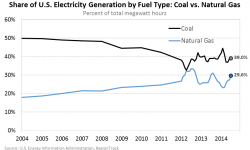Pic-of-the-Week: Has the Shift From Coal to Natural Gas Stalled? (10/06/2014)
Has the Shift From Coal to Natural Gas in Electricity Production Stalled? Just ten years ago, coal was used to generate 50% of U.S. electricity while natural gas held only an 18% share. Toss in the shale gas revolution and move forward to early 2012 and you have both coal and natural gas producing 32% of U.S. power each. It appeared natural gas was well on its way to replacing much of the coal-fired production in the U.S.
However, our pic-of-the-week illustrates that since early 2012 the shift has taken a clear short-term breather. Coal has made a small comeback and is now closer to 40% of total production. Natural gas has eased back a bit to just under a 30% share. Is the shift from coal to natural gas over?


